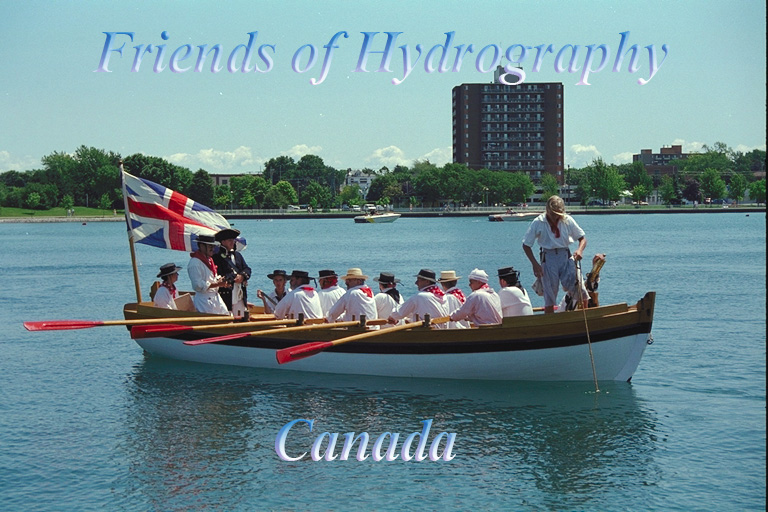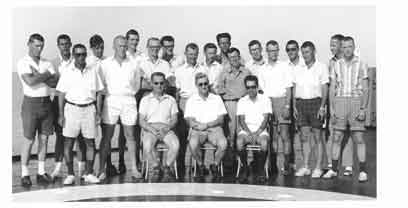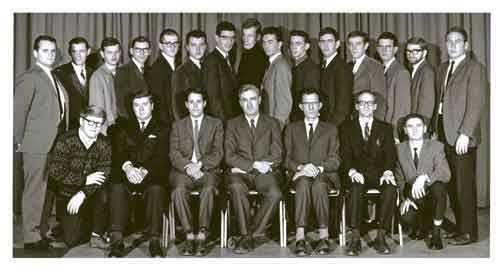Hydrography I Course (Hydro I)
This course, initially called the Basic Hydrography Course, evolved over a period of time.
In the beginning it was a straight computation course designed to standardize computation methods within the Canadian Hydrographic Service (CHS). This was deemed necessary because of the different procedures used for the computation of geographic positions, inverse solutions, triangle computations, astronomical observations etc. Up until this time the party chief of every survey party used whatever method he was familiar with. It was difficult for junior surveyors to move between parties as the methods of computation had to be changed.
In 1953 Paul Brunavs, then Assistant Nautical Geodesist, gave the first computation course to a group of senior hydrographers. This course may have been about two weeks in length. The same course was repeated in 1954.
From 1955 to 1957 a similar course was given by the Nautical Geodesy Section to intermediate level hydrographers. In 1957 Paul Brunavs became Head of Nautical Geodesy. In the winter of 1956/57 Sid van Dyck was brought into the Nautical Geodesy Section to be brought up to date on the many computation methods that had been selected to be the standard ones for the CHS. Along with the standardized methods selected, new computation and observation forms were developed and were introduced to all field parties. It must have been about this time that it was decided to give a basic hydrographic surveying and computation course to all new entrants to the CHS field staff.
At this time recruitment for field staff included many diverse backgrounds. The majority came with a background of university, survey school, or marine ship’s officer. The training program was intended to give the new recruit sufficient practical background to be useful on any survey party he was assigned to. It should be noted that this was strictly a training program of how to do things, not why things were done that way.
This type of course was first presented in 1958. Sid van Dyck was the instructor under the nominal supervision of Vic Goodwill. The course duration would have been about six weeks. The 1959 course followed the same pattern.
In the winter and spring of 1961 there were 12 trainees. The classroom course remained much the same for survey school graduates. For others a week (or two) of instrument training was added. This included the standard use of theodolites, levels, steel tape, invar bar and other common survey instruments. This part of the training program was carried out on the Experimental Farm in Ottawa. There was little change in 1961. It is likely that the tellurometer was added to the instrument training portion of the program at this time.
1962 saw a major change in the program. A pattern for the Hydrography I Course was established for many years to follow. The classroom and instrument training was maintained, but field training on a survey ship was added. Mike Bolton was put in charge of field training with Sid van Dyck as assistant. The CSS Cartier was used as the survey vessel. She carried two launches and was equipped with all the instruments necessary to do a basic hydrographic survey. Horizontal and vertical control was established, water level observations were made, sextant sounding was carried out with Kelvin Hughes echo sounders, wharf plans were made and stretchline soundings, using a standard leadline, were taken. All this work was carried out on Lake Ontario.
1963 followed the pattern established the previous year. To make the program more valid for all regions, it was decided to carry out part of the field training in tidal waters. The CSS Cartier was once again the training vessel. The area of operation was changed to include Lake Ontario and the Lower St. Lawrence River.
In 1965 recruitment of new hydrographers from the usual sources did not result in sufficient numbers. It was therefore decided to also recruit high school graduates with little or no survey background. This made it necessary to modify the training program. The ten high school graduates were to be given a preliminary training course from 6 July to 23 October. This preliminary training included classroom work and a five week field training program on Lake Ontario on board CSS Maxwell. This part of the program was carried out by Sid van Dyck who had been appointed Training Officer, John B. Larkin who had been appointed Assistant Training Officer and Neil Anderson who assisted in the classroom portion. This group of trainees joined the regular Hydrography I Course on 1 November. This course was given to a record number of 19 recruits. The classroom portion of this course was given in Ottawa and lasted until 21 December, with Earl Brown assisting.
Field training underwent a major change for this course. The CSS Baffin was made available for training in the Caribbean from 8 Jan to 1 April. Assisting the permanent training staff were Rene Pilote and in the initial stages Warren Forrester. Walter Kettle was the ship’s captain. The base of operation was Falmouth Harbour in Antigua where good weather was assured. En route to Antigua, about a one week cruise, the North Atlantic was rather rough. The time was used for instruction in oceanography and seamanship and navigation. After arrival in Antigua all basic aspects of hydrographic surveying were practiced. This included establishing horizontal and vertical control, various methods of sounding, shorelining, etc. Ben Buis, Lt. Royal Netherlands Navy, joined the program from 25 Jan to 24 March. He was a good shipmate and was an asset to the program. Once the basic field training was in hand a proper survey was undertaken. This included a survey of English Harbour and ship sounding off the south and southwest coast of Antigua. These surveys were, after completion of the field sheets, turned over to the British Admiralty for their usage.
HYDROGRAPHY I
1965/66
Standing L. to R.: D.V. Payn, H.A. Boudreau, C.W. Highgate, R.T. Whiffen, J.F. McCarthy, W.E.F. Burke,
D.L. DeWolfe, E.D. Bowlby, P.R. Bazilewich, D.W. Vallis, G.W. Rogers, F.W. Hall, E.F. Thompson,
J.S. Randall, A.R. Newman, R.D. Courtnage, B. Buis (Royal Neth Navy), P.V. Davies
Seated L. to R.: J.M.R. Pilote (Instructor), S. van Dyck (Instructor), J.B. Larkin (Instructor)
Missing: F.A. Coldham, H.M. Horton
1966 WEST INDIES TRAINING CRUISE (from a 1966 note)
There is no technical institute nor university which provides training in hydrographic surveying. The Canadian Hydrographic Service, therefore, has to train its own field staff and is doing so at the present time at the rate of 20 - 25 per annum. Training consists of class-room training in Ottawa during the fall and early winter. Training in the use of basic survey equipment and techniques under field conditions is carried out in southern waters.
Hydrographic surveying in Canadian waters is not practical during the winter months. The maximum field season extends from about mid-April to mid-October. Winter training, therefore, in other than Canadian waters makes possible the use of Hydrographic ships without interfering with the Canadian charting program.
The West Indies training cruise takes place during the first two to three months of the year and provides a continuous training period in an equable climate. The present cruise on which CSS BAFFIN has just left will involve the charting of waters in the neighbourhood of the Island of Anitgua.
Although the cruise is primarily oriented to training itself and not to chart production, the material collected is processed and forwarded to the British Admiralty for inclusion in Admiralty charts. A similar program undertaken two years ago in the vicinity of the British Virgin Islands provided the material which was incorporated into three Admiralty charts.
Provision is made on the training cruise for a small number of scientific personnel who are able to study various oceanographic disciplines while in the area.
In the fall of 1966, 18 recruits attended the classroom part of the course. The training staff was assisted by Al Smith. Field training, on the CSS Baffin, from Jan to April 1967 followed the pattern established during the previous year. The regions provided Bruce Wright and "Buzz" Connors to assist in the field training program. The basic training was again in Antigua. The production survey at the end was Discovery Bay on the north coast of Jamaica. This survey had been requested by the British Admiralty and passed on to them after the field sheet was completed.
HYDROGRAPHY I
1966/67
Back Row L. to R.: S.J. Statham, J.V. Crowley, G.H. Goldsteen, G.D. Macdonald, E.B. Clarke, G.M. Henderson, J.S. Warren,
A.R. Mortimer, R.R. McGee, R.A. Pierce, M.J. Kelly, R.J. Mahaffy, C.G. Miller, R.D. Popejoy, D.L. Nesbitt
Front Row L. to R.: T. Casserly, B. Wright (Inst), J.B. Larkin (Inst), S. van Dyck (Inst), A. Smith (Inst),
J.W. Connors (Inst), R.P. Haase
Missing: J.P. Mein
Classroom training for 22 new employees was provided in the fall of 1967 in Ottawa. This was followed in early 1968 by field training on the CSS Baffin. Vic Gaudet from Atlantic Region assisted in this part of the course. The training site was in St. Kitts. This was followed by a production survey of the deep sea harbour of Bridgetown, Barbados and included the approaches to the harbour.
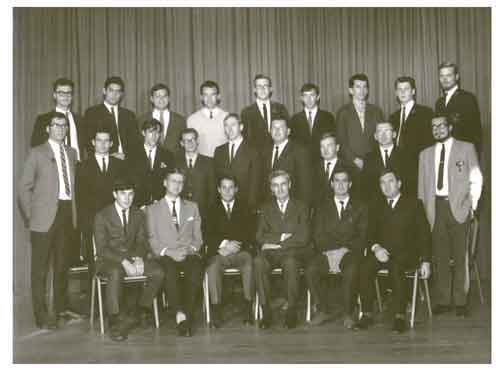
1967/68
Back Row L. to R.: J.H. Wilson, D.B. Jarvos, L.R. Lasnier, M.D. Price, B. Eidsforth, R.P. Janes, E.G. Howse, L.P. Landry, K. Highton,
Centre Row L. to R.: G.A. Walske, A.H. Curtis, W.A. Silvey, K.W. Daechsel, D.F. Courtnage, R.L. Tracey, K.G. Hipkin, A.T. Bent, R.G. Fairn
Front Row L. to R.: M.J. Casey, R.E. Chapeskie, J.B. Larkin (Inst), S. van Dyck (Inst), P. Page, M.R. Grant
Missing: D.B. Mehlman
In 1968 there were 16 new employees. Frank Hall joined the training staff as Assistant Training Officer. The classroom training was again held in the fall in Ottawa. Gerry Rodgers assisted in the 1969 field training in the Caribbean. The basic training areas were Carriacou and Plum Islands in the Grenadines. Production surveys were in Montserrat and ship work around Redonda. Paul Brick was captain and Lorne Strum was first Officer.
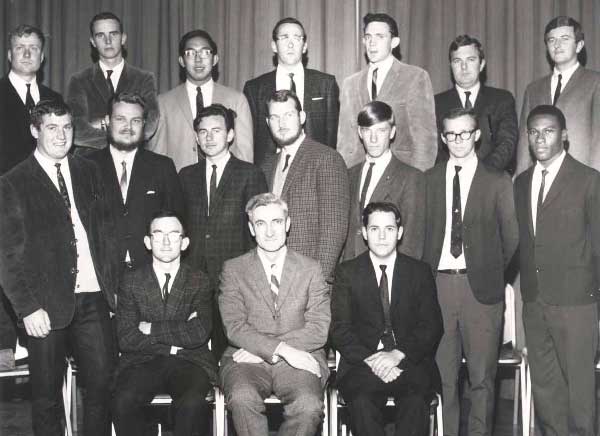
1968/69
Back Row L. to R.: E.G. Waugh, C.G. Lagasse, N.S. Fujino, D.J. Kean, R.A. Pierce, M.R. Grant, P.D. Richards
Centre Row L. to R.: P.A. Dal Bianco, J.I. Schneider, K.G. Spence, W.B. Millar, C.R. Tamasi, R.L. Moulton, R. Moses
Front Row L. to R.: F.W. Hall (Inst), S. van Dyck (Inst), J.B. Larkin (Inst)
Missing: G.G. Clark, R. Treciokas
The 1969/70 program followed the same pattern as the year before but with only 13 trainees.
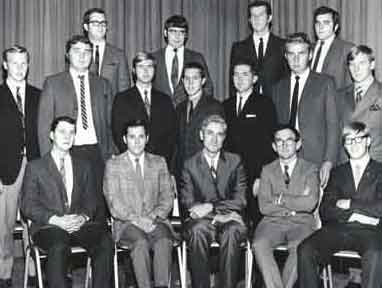
1969/70
Back Row L. to R.: M.R. Leitch, A.M. Canning, J.F. Dance, J.M. Gervais
Centre Row L. to R.: P.O. Lee, N.E. Bohatyretz, W.E. Doering, W.J. Danson, S.G. Greener, A.P. Welmers, J.A. Vosburgh
Seated L. to R.: R.G. Gillies, J.B. Larkin (Inst), S. van Dyck (Inst), F.W. Hall (Inst), G.R. Sellers
In the fall of 1970 classroom training was given to 17 trainees in Ottawa. Field training followed early in 1971. As the CSS Baffin was no longer available, training was moved to the Pacific Region. The training ship was the CSS W. J. Stewart. Saanich Inlet, on Vancouver Island, was the centre point of operations.

1970/71
BackRow L. to R.: R. Langford, J.R. MacDougall, R.A. Squires, J.H. Weller, B.T. Noel, R. Rehbein,
P. Page, D.G. Robichaud, D. Philpotts, M.V. Woods, D.L. Nesbitt, K. Barns
Front Row L. to R.: R.C. Robitaille, R.K. Beri, J.B. Larkin (Inst), S. van Dyck (Inst), F.W. Hall (Inst)
Missing: M. Crutchlow, D.J. Lambe, R.D. Popejoy
In the fall of 1971 the classroom part of the Hydrography I Course was switched to Algonquin College in Ottawa. The CHS training staff provided considerable assistance to get the course established there.
In 1971 John Larkin was transferred to the West Coast Region and Charles ,"Chuck" Leadman was transferred to Staff Training from Central Region to take part in the classroom portions of all hydrographic training courses.
Field Training for 15 trainees was once again on the West Coast from February to May 1972. In addition to the use of the CSS W.J. Stewart, a shore-party was established at Chemainus. Training assistance was provided by Ralph Cameron, Jake Kean and Jim Vosburgh.
The classroom portion of the course, from Sept to Dec 1972, was again given by Algonquin College.
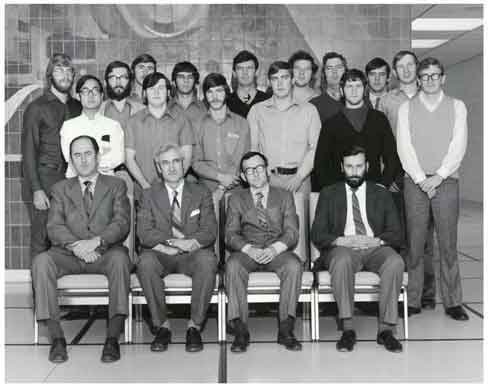
1971/72
Standing L. to R.: J. Medendorp, R.Y. Yee, P. Roberts, B. Ruby, J.E. Goodyear, B. Smith, C.J. Lanteigne, H.J. Marshall,
D.A. Blaney, R.C. Hlina, G.H. Eaton, J.P.Gaudet, E.I. Norman, A.R. Raymond, D.B. Kelly
Seated, Instructors, L. to R.: C.M. Leadman, S. van Dyck, F.W. Hall, J.W. Coles (Algonquin College)
In 1973 the CSS Baffin was again available for field training. The Caribbean was a much better training ground as far as weather and other conditions were concerned than the West Coast of Canada. The ship left Halifax on 15 January. The training part was carried out in the Grenadines, with Canouan Island as our main base. The production surveys carried out were Roseau Roads, Dominica, and Kingston Harbour, St. Vincent. Ross Gillies from Atlantic Region and George Goldsteen from Central Region assisted the training staff. 14 trainees participated in this program. On the return trip the hydrographic complement of the Baffin was off-loaded in Bermuda and the ship turned over for oceanographic work to a group brought out from Halifax. All hydrographic personnel were flown to their respective regions from Bermuda.
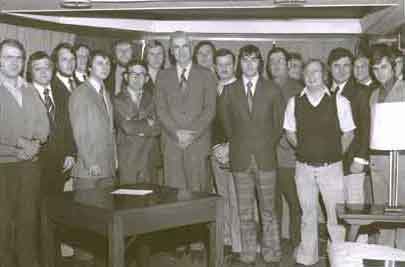
1973
L. to R.: G. Rockwell, D. Dakers, R. Solvason, R. McCready, R. Gillies (Supervisor), I. Campbell, F. Hall (Instructor),
C. Gorski, S. van Dyck (Instructor), L. Stillwell, G. Goldsteen (Supervisor), Y. Levesque, J. Ferguson,
B. Martin, R. Woodworth, R. Christian, J. Shaw, I. Charron, P. McCarthy
In 1973 Frank Hall was given the opportunity to take part in the University Training Plan. He was glad to accept this and moved to Fredericton to undertake his studies at UNB. For the CHS training program this meant that he was available only during the periods when the university was not in session.
The third Hydrography course at Algonquin College, from 10 Sept to 19 Dec 1973, saw Gerry Wade as chief instructor.
Field training underwent a considerable change in 1974. The CSS Baffin was to carry out a production survey for Guyana. This included off-shore waters as well as the route into Georgetown, the capital. This, it was thought, could be combined with the training program. Burt Smith was Hydrographer in Charge of the project. Sid van Dyck was in charge of training and was to act as senior assistant to the project. The Baffin left Halifax on 21 Jan and returned there on 5 April. Guyana, with a lot of internal tensions, was not well suited as a training locale. The only place ashore to practice instrument work was in a fenced-in army compound, which was used for about a week by those trainees who had little or no experience with survey instruments. It was not felt to be safe to be ashore in random areas. All trainees were involved in ship and launch sounding, as well as in establishing control. Given another location this joint operation could have worked. As it was, a minimum of training objectives were achieved. At times it seemed that the production survey was hindered rather than helped by having the trainees on board. Jim Vosburgh joined the permanent training staff, as Assistant Training Officer, on 1 March, when he arrived on board the "Baffin". It should be noted that of the ten trainees, two were Guyanese and one was not yet a permanent member of the CHS.
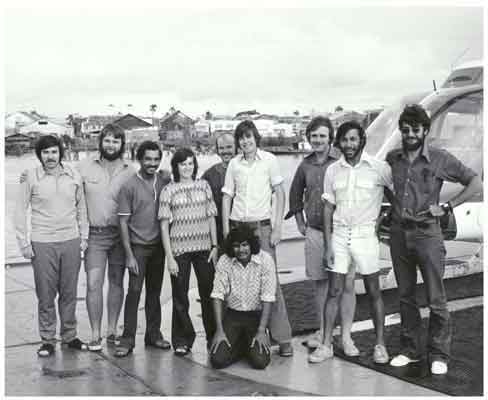
1973/74
L. to R.: G.L. Schuetzenmeier, D.G. Pugh, P.C. McDonald (Guyana), B.M. Flemming, R. Ball (not yet CHS), N.C. Darshan (kneeling, Guyana), S.R. Forbes, R.D. Mehlman, H.P. Varma, J.P. Blanchard
The fourth, and last, Hydrography course by Algonquin College was given from Sept. to 16 Dec 1974. Stu Dunbrack was the prime CHS instructor and liaison to the CHS.
In 1975 field training, once again, underwent a considerable change. For various valid reasons the "Baffin" was no longer available. A new plan had to be made for the nine trainees. The site chosen was Burlington. The Canada Centre for Inland Waters was prepared to support this endeavour. Expected weather conditions were such that the timing had to be changed, without the loss of too much field time for the regions. In the end it was decided to work out of CCIW from 1 March to 15 May. In addition and to add tidal water experience, the time from 16 May to 26 June would split the group with one-half the time spent on a production survey on the "Baffin", and the other half on a production survey with a shore-party working out of Montmagny P.Q. These training exercises would be coordinated by the training staff.
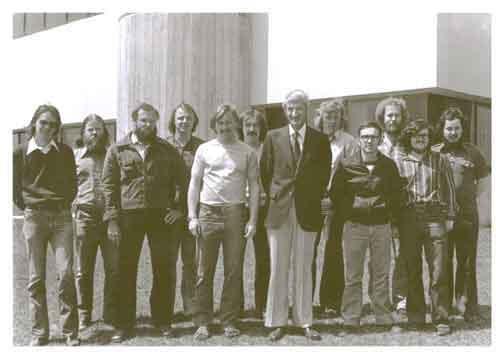
1974/75
Back Row L. to R.: Glenn Rodger, Kal Czotter, Barry Mooney, G.L. Langille, George Fenn, I. Grant
Front Row L. to R.: David Livingstone, Brian Power, Jim Vosburgh (Inst), Sid van Dyck (Inst), Frank Hall (Inst), Geoff Thompson
In 1976 the complete Hydrography I Course was given in-house. The classroom part for the 14 trainees was given in Ottawa from 13 Jan to 18 March. Field training followed the same pattern as the previous year from CCIW in Burlington. This lasted from 30 March to 4 June, except for the trainees from Pacific Region who returned to Victoria on 14 May to join their regular field parties.
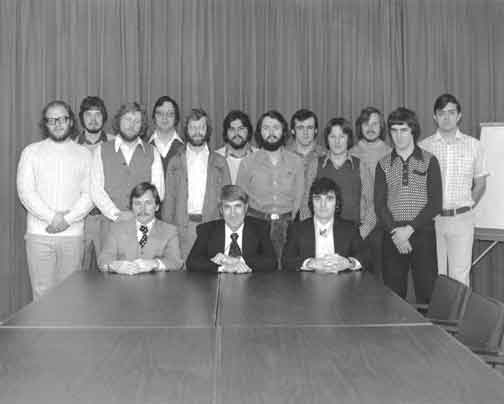
1976
Standing L. to R.: Gary Wanamaker, Al Koudys, Dale Woods, Charlie Sterling, Rod May, Brian Lefort,
Peter Lielland, Mike Power, Dave McCarthy, Peter Milner, Meiric Preece, Rainer Schoenrank
Seated L. to R.: Jim Vosburgh (Instructor), Sid van Dyck (Instructor), Mike Bennett
Missing: Mike Powell
The 1977 course stayed with the same pattern. There were seven trainees, one from Jamaica. Classroom training in Ottawa was from 11 Jan to 17 March. Field training followed at CCIW in Burlington. This was also the year when Jim Vosburgh returned to Pacific Region.
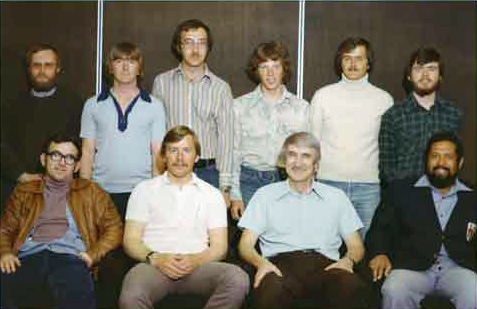
1977
Standing L. to R.: John Dixon, Gerard Costello, Ron Saucier, L. Prussner, Bob Covey, Kent Malone
Seated L. to R.: Frank Hall (Instructor), Jim Vosburgh (Instructor), Sid van Dyck (Instructor), Trevor Carnegie (Jamaica)
The 1978 course ran from 16 Jan to 1 June. Classroom training again in Ottawa, followed by field training at CCIW in Burlington. Frank Hall took over the training program for 17 trainees this year. He was assisted by Phil Corkum, Kent Malone, Jean Gervais and Charles LaGasse. Sid van Dyck, after a year on French language training was seconded to Nautical Geodesy.

1978
Standing L. to R.: D. Trudel, D. Holt, J. Gervais (Inst), G. Landry, D. Frizzle, J.Y. Poudrier, M. Hally,
M. Lamplugh, C. Allard, M. Ward, P. Corkum (Inst), D.Roop, A. Manley, M. Burke
Seated L. to R.: K. Malone (Inst), F. Hall (Head Inst), C. Lagasse (Inst), M. Ruxton
Kneeling L. to R.: P. Bellemaire, F. Burgess, R. Webb, R. Sargent
1979 saw some major changes in the Hydrography I training program. Frank Hall had transferred to Central Region. Peter Richards took over as Training Officer with Gunther Schuetzenmeier as Assistant Training Officer. Jake Kean assisted the program this year. Classroom training was in Ottawa for Seven trainees from 23 Jan to 29 March. One trainee was Nigerian, one from the Canadian Coast Guard and an Auditor from the Naval Hydrographer’s office. Field training, to 8 June was at the Institute of Ocean Sciences (IOS) in Sidney, B.C.
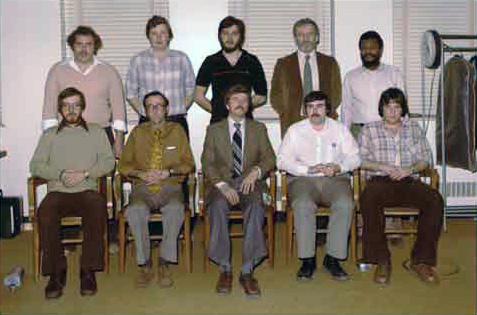
1979
Standing L. to R.: J.J. Biggar, Wm.P. van Duin, P. Elliott, C. Chaulk, C.O.C. Idigo
Seated L. to R.: L. Perkins, J. Kean (Instructor), P. Richards (Head Instructor) G. Schuetzenmeier (Instructor), D. Sewart
Classroom training in 1980 was from 22 Jan. to 27 March in Ottawa for four trainees. One was from a private Quebec firm. The other three had field training from 9 April to 12 June at the Bedford Institute of Oceanography (BIO) in Dartmouth.
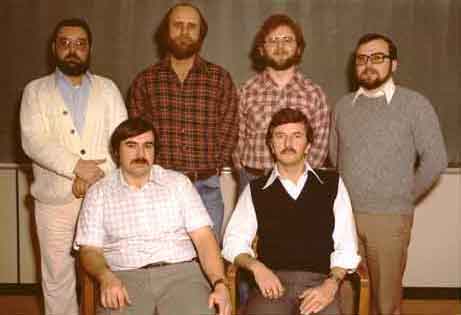
1980
Standing L. to R.: G. Bowman, B. McGowan, R. Palmer, N. Juneau
Seated L. to R.: G. Schuetzenmeier (Instructor), P. Richards (Head Instructor)
With only one candidate the 1981 Hydrography I Course was cancelled.
1982, with 11 trainees, including two from Nigeria, followed the established pattern with classroom training in Ottawa from 5 Jan. to 12 March. Field training was switched back to IOS, Sidney from 23 March to 27 May.
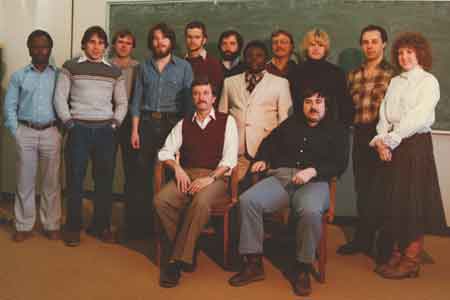
1982
Standing L. to R.: G. Pedro (Nigeria), M. Bastarache, S. Hinds, K. Halcro, D. Chase, N. Doucet,
B. Kikhiga (Nigeria), B. Richards, K. Lyngberg, D. Hughes, C. Rozon
Seated L. to R.: Pete Richards (Instructor) Guenther Schuetzenmeier (Instructor)
In 1983 classroom training was in Ottawa from 5 Jan. to 3 March. There were eight trainees, including two from the Pakistan Navy. All eight trainees participated in field training at IOS from 9 March to 20 May.

1983
Back Row L. to R.: Tariq Umer, Ron Wooley, George Yeaton, (Head Training & Standards)
Pete Richards (Instructor), M-A Baillargeon, Richard Sanfacon,
Front Row L. to R.: Guenther Schuetzenmeier (Instructor), Arif Hussain,
Paul-Emile Bergeron, Rob Hare, Carol Nowak
In 1984 the six trainees included one from a private firm, one from the Pakistan Navy and one from Jamaica. Classroom training, in Ottawa, was from 4 Jan. to 4 March. Field training at IOS was from 13 March to 18 May.
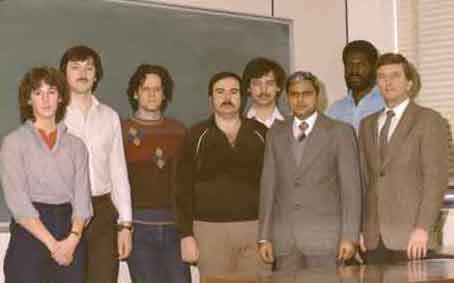
1984
L. to R.: Ann Ryan, Dale Nicholson, Byron McGregor, Guenther Schuetzenmeier (Instructor)
Harry Kuczak, Mohammed Riaz, Silburn Stewart, Pete Richards (Instructor)
The seven trainees in 1985 included one from a private firm, one from Jamaica and another one from a private firm who attended the classroom part only. Classroom training in Ottawa ended on 5 March. Field training at IOS ended 16 May.
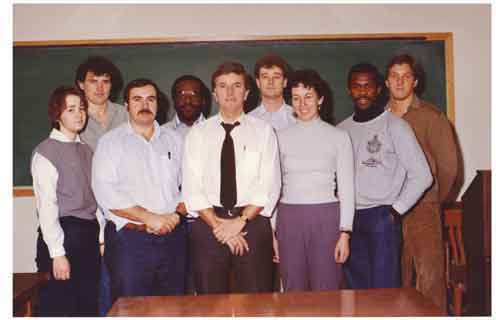
1985
L. to R.: Nathalie Johnson, Bruce Lewis, Guenther Schuetzenmeier (Instructor), Godfrey Thomas,
Pete Richards (Instructor), John Cunningham, Barbara Kerr, Archie McAllister, Robin Heath
In 1986 two separate courses were given. One of these courses was in English, the other in French. The English course saw classroom training in Ottawa from 13 Jan to 21 March for eight trainees, including 3 from Malaysia. This was followed by field training at IOS from 1 April to 6 June. Two trainees from Quebec Region joined field training here for two weeks. The French language classroom training was carried out in Quebec from 3 Feb to 16 April for 6 trainees of whom four were not CHS employees. Field training for this group took place in Montreal with Peter Kieland as instructor.
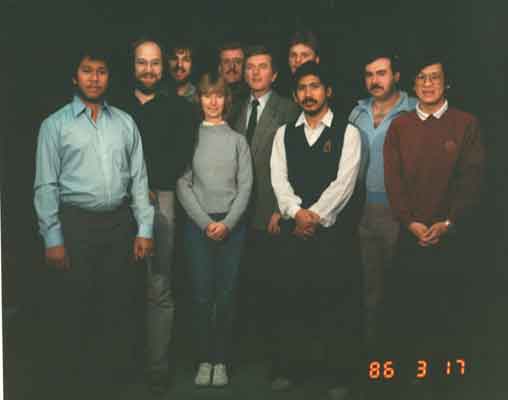
1986
L. to R.: Sham Suddin Yousoff (Malasia), Kirk MacDonald, Jean-Claude Vautour,
Terese Herron, Neil Sutherland, Peter Richards (Instructor), George Schlaginweit (back),
Alwi Ahmad (Malasia), Guenther Schuetzenmeier (Instructor), Lee Cheng Hock (Malasia)
The last Hydrography I Course was given in 1987. Of the six trainees three were from Ship Division and one was from BCIT. The classroom part was in Ottawa from 26 Jan to 20 March. Field training was at IOS from 30 March to 15 May.
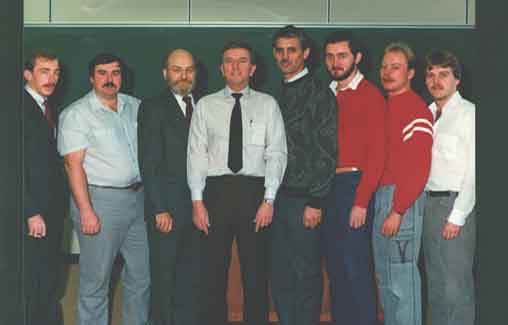
1987
L. to R.: Jim Dockrill, Guenther Schuetzenmeier (Instructor) Warren MacConnel
Peter Richards (Instructor), Don Jarvos, Graham Rankin, Dave Thornhill, Wayn Duffet
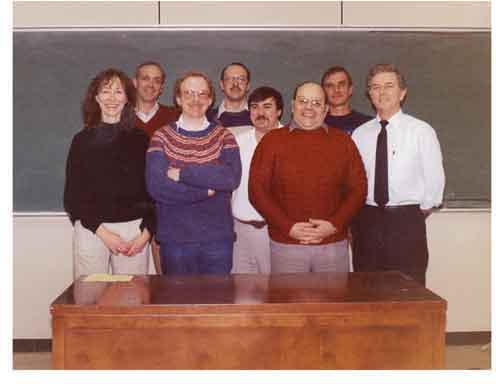
1989
L. to R.: Janet Lawson, Dave Fleming, Alan Smith, Paul Parks, Guenther Schuetzenmeier (Instructor)
Bert McCorriston, Graham Lutwick, Pete Richards (Instructor)
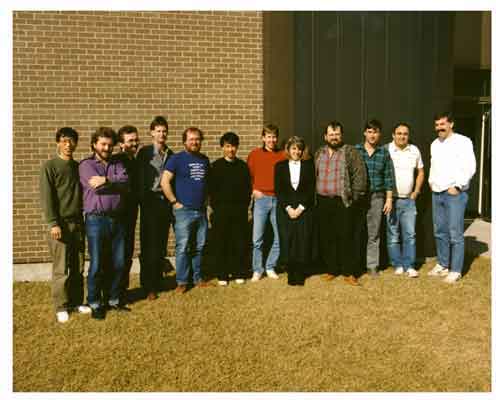
1990
L. to R.: Ok-Soo Kim, Mike Lloyd, Tom Roswell, Nick Palmer, Mike Collins, Shin-Ho Choi,
Stephen Nunn, Heather Joyce, Gary Sidock, Denis Pigeon, Alex Hantzis, Bob Murphy
